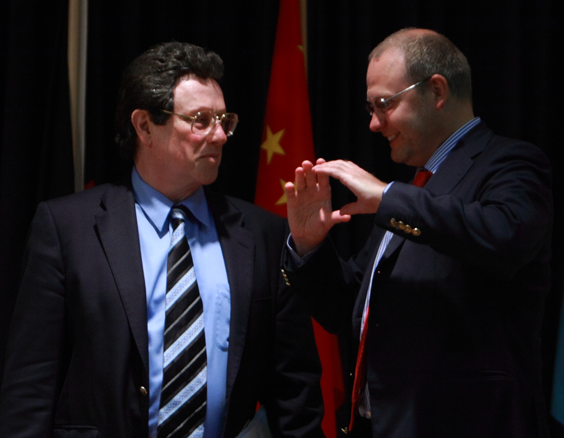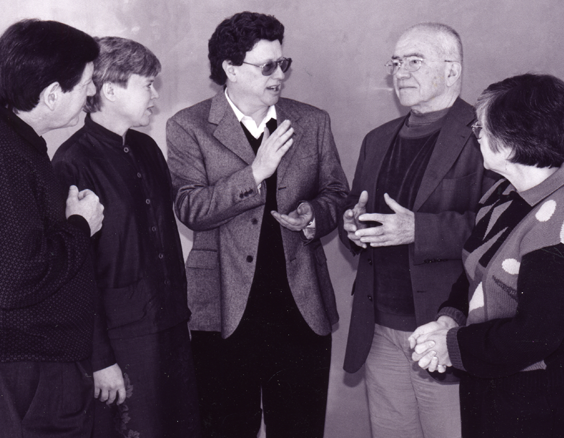June 16, 2020
The following is an excerpt of an interview conducted by the PIR Center’s Vladimir Orlov with CNS Founding Director, Dr. William C. Potter.
Read the full interview.
Orlov: Bill, you and I first met exactly 28 years ago. The first time I came to Monterey, I remember it very well, was in spring, 1992. Exciting times. And dramatic as well. I was in great company in Monterey when I first came. Andrey Zagorsky and you brought the whole group of Russian and other post-Soviet experts like Ildar Akhtamzyan, Dmitry Evstafiev, Elina Kirichenko Slava Paznyak, Evgeniy Sharov, Sasha Pikayev… Some of them, like Sasha, are no longer with us. I was a journalist then. But, when I look through my archives, I cannot find a single interview I made with you. OK, let’s start my first interview with Professor William Potter in 28 years…
I will start with an easy one. Your CNS turned 30. How and why did you decide to establish CNS, any why to establish it in Monterey? What inspired you?
Potter: I will try to give you a shorter rather than longer version of the story.
It’s complicated. It pertains to my formal graduate training at the University of Michigan that was in international politics and comparative foreign policy with a special focus on Russia or the Soviet Union. It was impossible for me, even at a huge graduate school, such as UM-Ann Arbor, to take any courses in nonproliferation; they simply did not exist at that time. Even some people like Larry Scheinman, who was my professor, taught courses in comparative foreign policy, but nothing in his own real area of expertise – nonproliferation. In a sense, I discovered nonproliferation for myself when I did a postdoc at Stanford and met some students who subsequently hired me the following summer when I was teaching at Tulane University.
In any case, while I was working for these three former students, who had formed their own company, my task was to review the literature on nonproliferation. In the course of doing that review, I was really struck by parallels in US and Soviet nuclear export policy, and I began to focus on that subject for research. It seemed to me that maybe one could derive some lessons from how it was possible for the nuclear superpowers in the Cold War to cooperate on nonproliferation and extend them to other areas. This all took place well before I came to Monterey.

Dr. William Potter with Dr. Vladimir Orlov
I also had begun a project at UCLA called “The Emerging Nuclear Suppliers Project,” which was designed to use open sources to compile a database for tracking international nuclear commerce. I got my first two grants from the Rockefeller Brothers Fund (our mutual friend, Hilary Palmer) and from the Ploughshares Fund– one of the very first grants they gave. When I came to Monterey and I wanted to sustain that database, I found that I had no students, who were knowledgeable about the subject.
When I came here to Monterey, I was given a full professorship and I was put in charge of what was then the Soviet Center, but there were no nonproliferation courses offered. I began to offer the courses and to train some of the students, but I had no staff that could really work with me on this project.
My very first research assistant was Gary Gardner, who knew a lot about Latin America but nothing about nuclear trade. So, I began to offer courses, but I also thought that it made sense to more formally develop the training and research program. I founded, what at first was a project, but then became a Center. I would say it really took off when I got a number of other grants, from the W. Alton Jones Foundation, from the Ford Foundation, and particularly from Carnegie Corporation of New York, as well as some others. These grants enabled me to hire more personnel. One was Clay Moltz, who joined the staff as a recent PhD.
Obviously, Roland Timerbaev was absolutely the key. I have Hilary Palmer to thank for that hire. She called me, and I do not know how she learned of this, but she learned that Amb. Timerbaev might be available.
I reached out to our President, Bob Gard, and I said that I would really like to hire this unusual individual, and I know that Ambassador George Bunn at Stanford is going after him. But I want to hire him immediately. He said: “If you have the funds, go for it.” I was able to count on the Rockefeller Brothers for support and almost instantaneously we had Roland in hand.
I cannot recall the precise day, or exactly how, the idea of a Center per se dawned upon me. It began by having a few key individuals with me and some modest resources. Then we had a key project that enabled me to hire students and engage them in a tangible activity. That was the Emerging Nuclear Suppliers Project database. We developed a methodology for searching nuclear trade publications – Nuclear Engineering International, Nuclear News, Nucleonics Week, and Nuclear Fuel – all which were publicly available. They were very expensive. You could not even find most of them in the major research libraries at the University of California Berkeley, UCLA and the like, but you could subscribe to them for thousands of dollars. We did that, and the students learned about nuclear technology on the job by building a database for tracking international nuclear commerce. And then I would offer nonproliferation courses and hire students to work on the project with me. That’s how many folks joined the program: Lisa Moskowitz, Lynne Huizinga, and others. Plus, we had some people working at the Soviet Center which then became Center for Russian and Eurasian Studies. We also were able to market our databases. The International Atomic Energy Agency (IAEA) was one of the first to subscribe, but they hired away a number of my key staff over the years: Michael Barletta, John Leppingwell, among others. Initially, they sent people here for training, but then built up their own open-source data collection processes.

Dr. William Potter with Amb. Roland Timerbaev and other friends.
The other major thing that assisted the Center in its development was the fact that I was one of a very few individuals — one of three — who had been trained as Soviet specialists who were also well-versed in nonproliferation issues. When Graham Allison and Ash Carter at Harvard began to focus on the question of loose nukes, I began to interact with them. When a flood of news stories began to break, I was in a position to comment on them. Now Jeffrey Lewis does much of this, but at that time I was on 60 Minutes, NPR, and all of the major television news programs. We had unusual knowledge, including about the infamous Chetek Corporation case [a Soviet/Russian company lobbying for peaceful nuclear explosions during the times of disintegration of the Soviet Union], and that helped to build up our visibility.
What we set out to do – to train the next generation — is exactly what we actually did. It was remarkable how close the concept was to the project’s implementation and what we remain faithful to today.
That idea which, which was well-honed, enabled us to secure funding. In retrospect, it’s hard to believe that we actually were able to do what we did. I had the right people. We were really fortunate with that initial group, and in bringing them over here for training. Ildar [Akhtamzyan, Associate Professor at MGIMO-University] was our very first visiting fellow. And it was key to find people who were interested in working professionally in the field, not just coming to the United States and enjoying themselves. We just had this remarkably successful selection process. Then the project grew almost on its own accord.
It now seems like such a daunting activity, it makes me exhausted to think what we were able to accomplish at that time. There were so many stories associated with these early trips, our first meeting in Nakhabino, my interactions with lots of our friends today: Anatoly Antonov, then an export control official, used to come to our meetings; Vladimir Shkolnik [Soviet and Kazakhstani prominent nuclear physicist, former senior official in Kazakhstan. He was Minister of Industry and Trade (2006-2007, 2008-2009) and Minister of Energy of Kazakhstan (1999-2006, 2014-2016), head of Kazatomprom (2009-2014)] used to play tennis with Lisa [Moskowitz, in the past a CNS staffer, now at the U.S. Department of Defense] and me in Minsk when we had one of our meetings there.
Those were remarkable times. I have always had an impression, and it may be a mistaken one , that at that period in my life, particularly, as it applied to the Soviet Union and the early post-Soviet period, I felt that absolutely anything was possible: you could dream, you could have great plans, and if there were some logic to the plan, it could be realized. You could think big and that was a kind of recipe for our successful activities. We had these very great expectations, we had great partners from the very beginning. I like to think – and maybe I’m mistaken – but I like to think that unlike some aspects of Nunn-Lugar Cooperative Threat Reduction Program from the very beginning we saw our partners in the Soviet Union and in Post-Soviet societies as truly partners. We got so much out of our collaboration with them; we gained as much as we gave to them. They came here, we offered them training, but we learned so much ourselves. That’s why whether it’s with you or with Dastan [Eleukenov, a Kazakhstani diplomat, since 2019 – Director, Department of international security, Ministry of Foreign Affairs of Kazakhstan] or Slava [Paznyak, a Belorussian political scientist] and all of these parties with whom we interacted we developed working relationships that assisted us tremendously. I see that as perhaps the most important ingredient in our recipe for growing rapidly.
Read the full interview.
